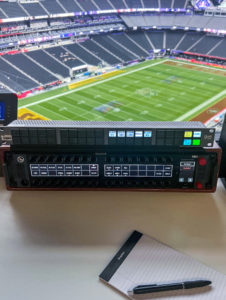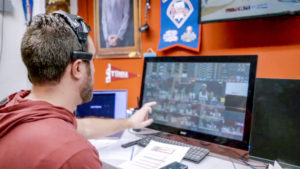We spoke to Olivier Suard, Vice-President of Marketing, Nevion, about the company’s leading role in the EU’s VIRTUOSA project which aims to take advantage of the potential of 5G in live production.
Before we get into discussing the VIRTUOSA project, please remind us of the background of Nevion and give us an overview of Nevion today
As the self-styled architects of virtualized media production, Nevion specializes in helping broadcasters and service providers revolutionize the way they do business, by transforming broadcast workflows using IP network technology and IT concepts like virtualization. This positions Nevion in the ‘PRODUCE’ area of the IABM BaM Content Chain®.
When it was first founded in 1996, Nevion (then called Network Electronics) specialized in providing hardware products for the transport of video, audio and associated data, primarily in the facilities. Over the subsequent years, other companies (VPG and T-VIPS) merged into Nevion, bringing IP and WAN (wide area network) expertise with them. As a result, Nevion became a pioneer of IP media transport both in WANs and LANs (facilities). However, in the past five years, Nevion has transformed from being a supplier of hardware products into one that delivers transformative solutions based on software-defined products and with associated services. The solutions are focused in four main areas within the broadcasting business: facilities, contribution, remote production and terrestrial distribution.
Nevion solutions are used to power major sporting and live events across the globe. Some of the world’s largest media groups and telecom service providers use Nevion technology, including AT&T, NBC Universal, Sinclair Broadcast Group Inc., NASA, Arqiva, BBC, CCTV, EBU, BT, TDF and Telefonica.

Tell us about the VIRTUOSA project – what is its objective, who are the partners and how you will measure its success?
The purpose of the EU-funded project VIRTUOSA is to explore through real-life examples how 5G (the Fifth Generation of Cellular Network Technology) wireless communication can be combined with virtualization concepts from the IT industry to enable broadcasters to produce live content (such as sports or music coverage) more efficiently and cost-effectively across locations, to meet growing consumer demand.
The project involves four international leading industry players with complementary competencies: Nevion AS (Norway), Mellanox Technologies LTD (Israel), LOGIC media solutions GmbH (Germany) and IRT – Institute for Broadcasting Technology (Germany). These partners bring to the project expertise in, amongst others, IP networks including SDN (software defined networking) and virtualization, media transport, network architecture and system design, as well as real-life experience of broadcast production.
The ultimate aim of the project is to develop and launch a product (or solution) that will enable virtual connections of any studio, control room and on-site production across multiple locations, and live feedback from the audience straight into the production chain via 5G acquisition.
For this purpose, the VIRTUOSA project received a grant of €2 million from the European Union’s Horizon 2020 research and innovation program, ‘Fast Track to Innovation’.
Nevion is leading the project – what special expertise and experience are you bringing to the table?
The VIRTUOSA project fits into Nevion’s core expertise of real-time media transport over IP networks. Nevion is bringing to the table a wealth of experience in creating solutions that enable distributed live production and virtualization of resources.
One of the keys to the success of the VIRTUOSA project will be the ability to orchestrate real-time signals across LANs, WANs and 5G networks. Nevion’s orchestration and SDN control software, VideoIPath, will be used to deliver that essential capability.
Is 5G the missing link in viable remote production? Tell us about its advantages and the potential it can unlock
It is no secret that broadcasters are looking to do more with less – create more content with fewer resources. One aspect of achieving that goal is to become more light-weight and nimble in the process of acquisition, and to centralize the production to make optimum use of equipment and production staff.
The trend for IP based remote production fits squarely within that framework. With 5G though, the acquisition becomes even more portable (e.g. fewer cables) and more mobile. This means that broadcasters can set up on site more quickly and cost-effectively almost anywhere, to handle breaking news for example. It also means that events that require tracking over considerable distances, e.g. sports such as cycling, road running, or cross-country skiing, could become easier to cover.
5G can also be used as back-up link for more conventional remote production connections, which is expected to be more versatile and economical than traditional diverse routing over fixed connectivity.
How will you solve the critical issues of timing and security of pairing?
One of the purposes of the VIRTUOSA project is precisely to investigate the performance of timing distribution over 5G connectivity, and in particular whether the intra-5G network timing distribution will be sufficient for all of the standard IP requirements. That said, separately, Nevion has been investigating how real-time production can work effectively with latency that historically has often been considered unacceptable, and it is clear that there are additional ways to reconcile timing downstream, so this area is not critical.
Security is important in several levels. The key areas are authentication of the devices, encryption of the content and secure control channels. There are both existing and emerging standards that can be applied to this area, and it is anticipated that the VITUOSA project will investigate these also.
Are there any extra considerations from a management/orchestration point of view with 5G?
A key area of exploration within the ongoing work on 5G is that of interfacing to the control API of the 5G orchestration. There is potential within the future technical capability of 5G for dynamic setup and teardown of connectivity. Using an API into the 5G orchestration system would potentially allow a media orchestration system such as Nevion’s VideoIPath to create end-to-end media flow provision over a hybrid of fiber and 5G IP connectivity. This feature, like many elements of the 5G technical potential, would rely on service providers being willing to open this capability and provide it as a service.
What will it take to persuade carriers to put aside a ‘custom slice’ to enable the guaranteed quality of service that 5G live contribution requires? You are competing for bandwidth against some very big potential payers!
The first point to make here is that a ‘custom slice’, i.e. dedicated bandwidth, may not always be required. For example, where 5G is used as a backup connection for contribution, using 5G ‘as is’ may well be good enough, in the same way as the Internet, with its fluctuating bandwidth, can provide good enough connectivity as a backup. It’s largely down to the balance between the cost of the bandwidth vs. the probability of it being needed.
Of course, where 5G is used as the main connectivity, a guaranteed bandwidth will be required. That’s when a ‘custom slice’ would need to be negotiated with telecom service providers.
The biggest challenge when we start talking about Custom ‘QoS’ slice provision with dedicated bandwidth is whether service providers will see a sufficient large potential market in these services to make them worthwhile providing. Broadcast contribution alone is unlikely to provide sufficient stimulus for this, but combining forces with other ‘niche’ areas such as emergency services, more generic dynamic event-based data requirements and maybe military applications could make this approach viable.
In the context of remote production (which is what the VIRTUOSA project is primarily looking at), the 5G connectivity is typically needed in a very specific location and for a very time-delimited period. This makes the case for the allocation of bandwidth much easier to make in that it is less likely to be in competition with other uses.
Of course, it will also be down to pricing.
It is not the purpose of VIRTUOSA to investigate this aspect of 5G in broadcasting – it is looking at the technical aspects. The working assumption for the project is that there is a strong business case for broadcasters to use 5G, and they will work to overcome the issue of competition for dedicated bandwidth.
When will 5G-enabled remote production become practical? What barriers are still to be overcome?
The technical issues surrounding the transport of media over 5G networks can be overcome in fairly short order. The VIRTUOSA project for example is set to run for just 24 months.
The biggest issues will be the speed of roll-out of 5G and its performance (actual vs. theoretical), providing sufficient capacity and geographical coverage.
Finally, Nevion has been an IABM member for some time. What are the most valuable IABM services from your perspective?
As a neutral organization for the professional broadcast sector, IABM can facilitate information and knowledge sharing across the industry and stimulates valuable debate in a unique way. For Nevion, which has always believed in industry collaboration (through the adoption of standards or business partnerships) this debate serves to cement that process.









